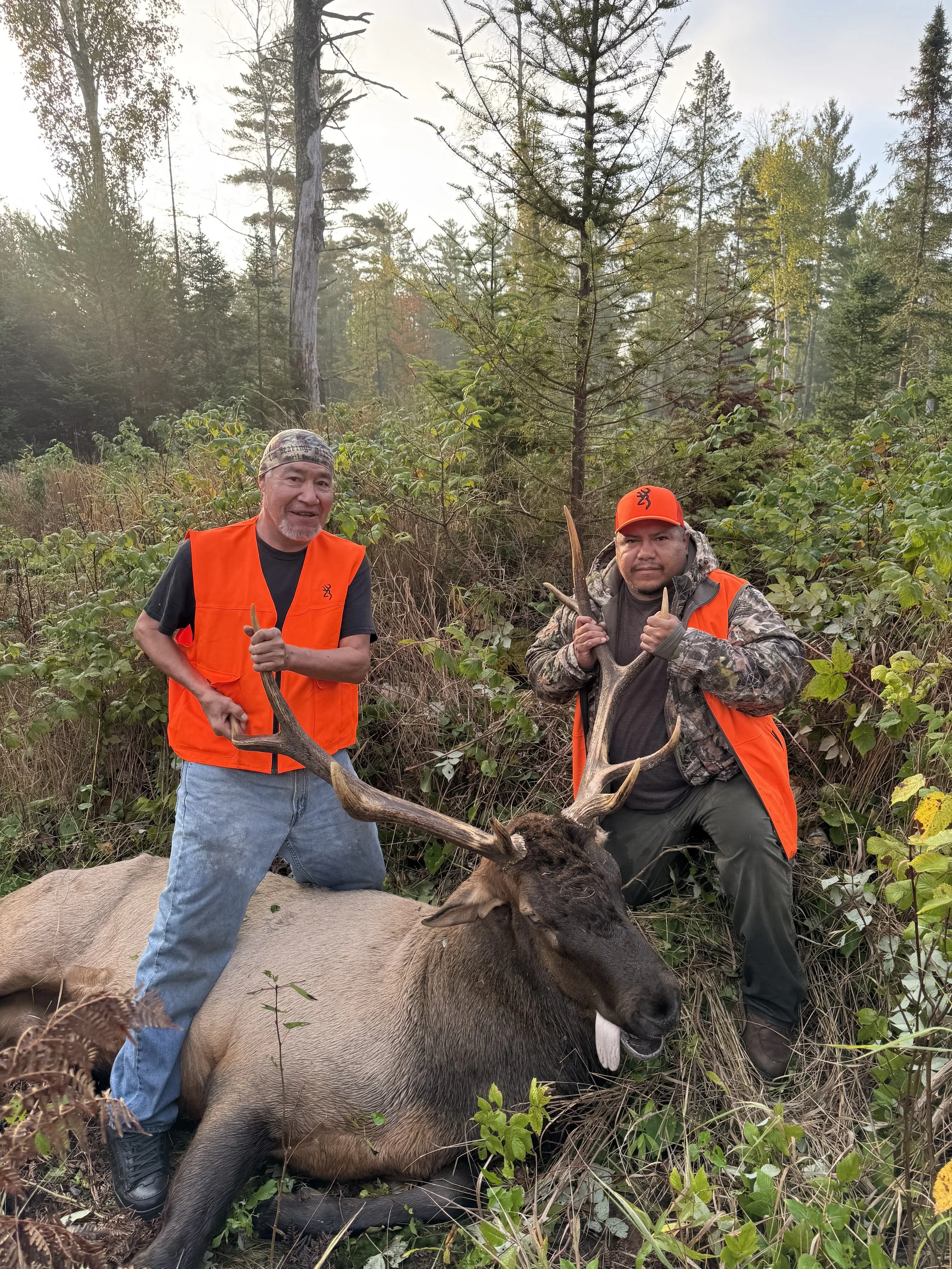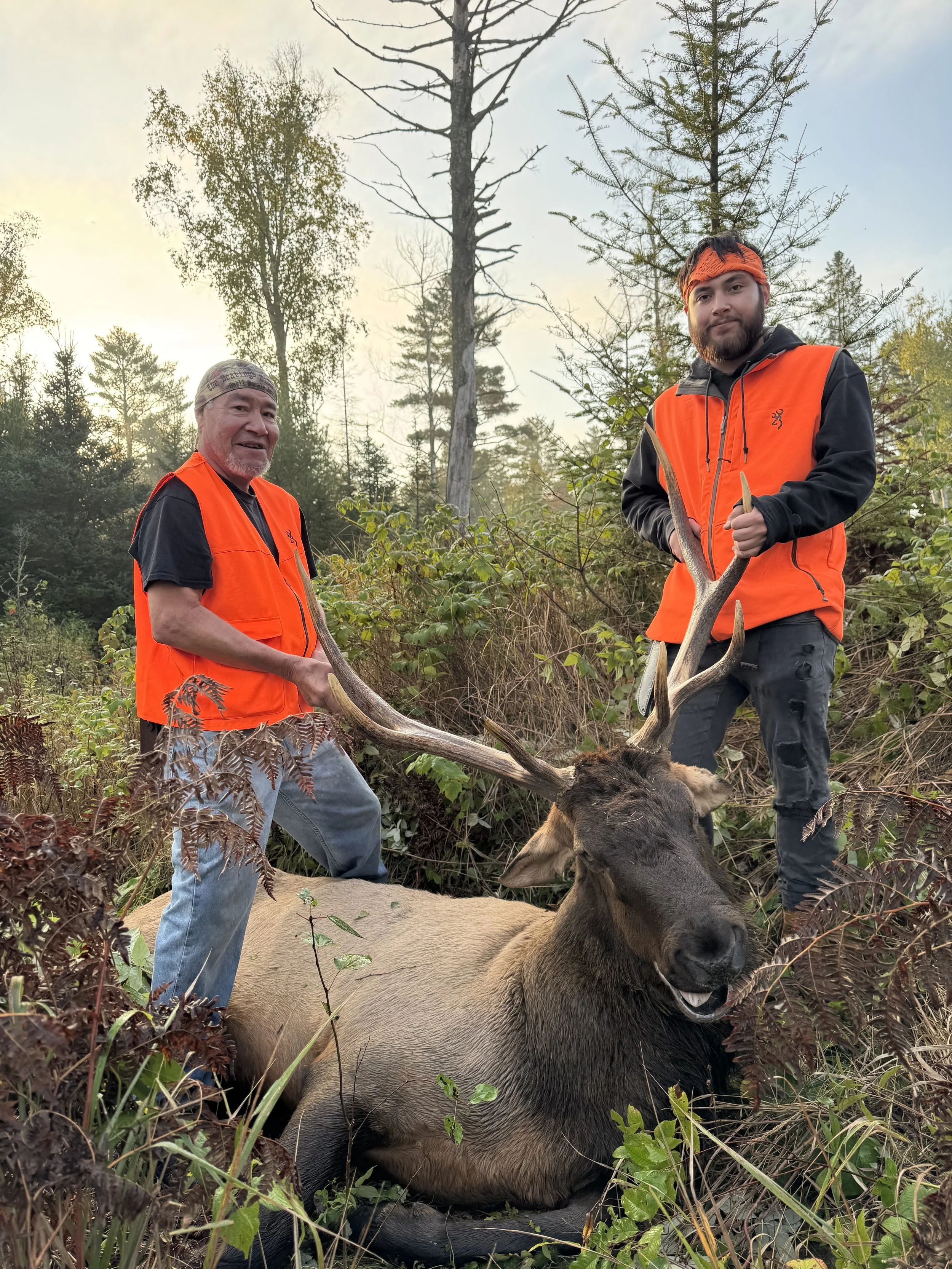RETURNING THE OMASHKOOZ: THE REVIVAL OF THE WOODLAND ELK
From near-extinction to thriving herds, collaborative efforts between tribes, biologists, and state agencies bring the elk back to Northern Wisconsin — preserving cultural traditions, ecological balance, and the hunt of a lifetime.
By Mashkodebizhikigahbaw - Benji Sam
Before the settler expansion into the heart of North America, a once plentiful resource walked the woodlands, plains, mountains, and even the great Northwoods of Minnesota and Wisconsin. In the last 200 years, multiple fur trade routes, voyagers, and logging camps began to exploit this once great resource to change its historical range across North America. While offering an extremely valuable protein resource for all who lived across the Northwoods, the omashkooz (elk) added to the great density of cervid species across the local ecosystems of Minnesota and Wisconsin.
Writers in the 1800s spoke of the ease of hunting these elk compared to other game species more familiar than them due to having never really seen strong human pressure much less long-range capacity weapons. Over the course of time, as more settlers began to inhabit the unscathed landscape of the Midwest, increased pressure, over-harvest, and developments of more proficient weapons at distance began to displace the elk herds of the woodlands into new territories. By the year 1886, elk were completely eradicated from the landscape, leaving tribes across the Midwest wondering where the once plentiful omashkooz had gone.
Over the last 100 years we began to turn the page on reviving the once plentiful elk herd in Northern Wisconsin and in the 1930's elk were reintroduced into the central Wisconsin landscape. Over the next 18 years, this re-introductory effort would fail largely due to poaching and illegal harvest of the elk. Various attempts have been made throughout the last century since then, with none really gaining traction until the efforts put forth in 1995 within the Treaty Boundaries of 1837 and 1842 in the Chequamegon National Forest.
In 1995, 25 elk were introduced into the Clam Lake, Wisconsin area from neighboring Michigan where their herd health remained strong. These elk were supplemented in 2017 with 31 additional elk and again in 2019 where 60 more elk were translocated from the Kentucky herd to help diversify the genetic strain of elk and to further improve herd health across the landscape of Northern Wisconsin. GLIFWC Biologist Travis Bartnick said, "The most recent assessment we have available puts the total herd around an estimated 356 elk in total, with nearly 80 bulls, 184 cows, and around 92 calves." This fits the target goal for bull to cow ratio for the Clam Lake herd and maintains the ability to continue allowing safe harvest practice.
With this safe harvest practice, and through the diligent efforts of local tribes, state DNR, GLIFWC, and multiple biology teams in place, the Clam Lake herd has continued to grow as well as the development of a second herd outside of the ceded territory. "The overall elk program goal is to maintain a healthy, robust, and sustainable elk population that provides the ecological, social, economic, and cultural benefits of elk while minimizing elk-human conflicts in Wisconsin," said Bartnick. "The goal over the next 10 years is to maximize herd growth while also providing hunting, recreational, and wildlife viewing opportunities."
By 2018, Wisconsin and the Voigt tasks force with the aid of biologists and the DR determined that the herd had now boasted the health enough to maintain safe harvest practices. As a result, a total of 10 tags were issued - split between tribal members and state hunters — for the inaugural elk hunt. Wisconsin residents can apply for an elk tag annually, with the chance to win a once-in-a-lifetime hunt for a bull elk taken from the Woodland herds of Wisconsin. This drawing helps boost resources and time devoted to maintaining the health and habitat for these elk to thrive on a landscape they once inhabited without human intervention. Half of those annual tags are to be distributed among the 10 affiliated tribes who are selected each year to participate in the ceremonial elk hunt.
This year, Mille Lacs was awarded a tag and a team consisting of Billy Joe Boyd, Joseph Boyd, and Ezra Sam took part in the opening ceremony at the Clam Lake elk camp with all tribal hunters, biologists, Elders, and experienced elk hunters who have been with this hunt from the beginning. Tobacco is given, sage is burned, songs are sung, weapons are blessed, and each team is given information on what next steps to take following a successful harvest. "It was very cool to see the collaborative efforts of everyone involved and to hear from experienced hunters on what to look for and how to approach hunting these large animals," said Ezra Sam. "They are enormous compared to a white-tailed deer and learning about an unfamiliar place made it a great adventure."
The next day, the first day of the hunt, the Mille Lacs crew gathered up and set out to hunt an area they scouted the day before and found some strong sign to follow up on. "We drove up to a parking area going in and began to walk back into the area we saw a lot of elk sign and a lot of shooting from duck hunters in the distance," Sam said, "it wasn't long before we heard two bugles that sounded almost so perfect they sounded fake." Chaos ensued as the crew found themselves within eyeshot of a massive bull elk.
It was then, Sam said, that crew member Billy Joe took the first shot into the bull and the great beast barely even flinched, so a follow up shot was needed before the bull began to run into the distance. After 20 minutes of waiting, the crew began to track the animal, coming across the bull and requiring a third and final, fatal shot from team member Joseph Boyd before the bull finally expired peacefully. A true team effort, and while the excitement began to come back down to earth, this set off the chain of events that makes this hunt so special. "After confirming a harvest, we had to follow directions from the biologist to take samples of organs, blood, the hide, and to make sure we kept them on ice so the samples could be used for gathering data from the harvest," said Sam.
This data is used to track herd health, growth rates, and to gather all information of the life cycles of each bull as they are harvested annually. "The bull the Mille Lacs team harvested was a 16.5-year-old bull, born in spring of 2009 and given an ear tag for future identification. He was one of the oldest bulls on record since the reintroduction efforts started in 1995, and was the oldest bull harvested since regulated hunts began in 2018," according to Bartnick. "Bull 289 was observed to have worn down teeth, even missing some teeth, and was a 4x5 antler structure indicating he was on the decline age wise, and was likely at least a 6x6 in years past."
This is the type of bull the biology team aims to have harvested each year; to maintain herd health and strong genetics into the future, mature and declining bulls offer a strong opportunity to create the hunt of a lifetime. According to Billy Joe Boyd, this was the hunt of a lifetime and the excitement of sharing that with friends and family made for an unforgettable adventure. Once the harvest was made "the work began," he said indicating it took more than four hours to field dress, cape, quarter, debone, and transfer meat back to the vehicle to get in a cooler for preservation. "These are amazingly strong, tough animals and we needed to stop to sharpen our blades often in order to finish the job," added Sam.
All meat taken from these elk is distributed after being commercially processed and distributed throughout all affiliated tribes to use for ceremony, feed elders, those unable to hunt for themselves, and continue the stewardship practices taught by those who took their journey before us. With any luck, and with the aid of all parties involved, this is a renewable resource that can be maintained into the future for generations to continue hunting woodland elk in Northern Wisconsin.
For future hunt lotteries, information regarding any of the special hunts offered throughout Minnesota, Wisconsin, and within the Treaty of 1837 Boundary, please follow the Mille Lacs Band Tribal DNR social medial pages.
The Mille Lacs team of Billy Joe Boyd, Joseph Boyd, and Ezra Sam harvested one 16.5 year old bull elk in the 2025 elk hunt this fall


